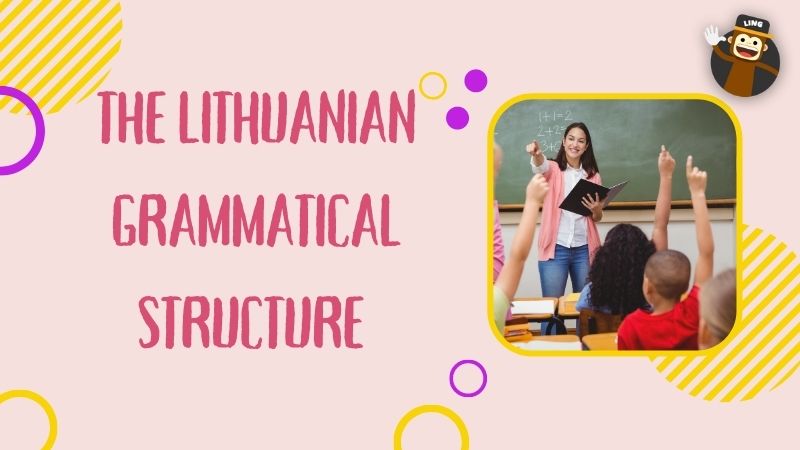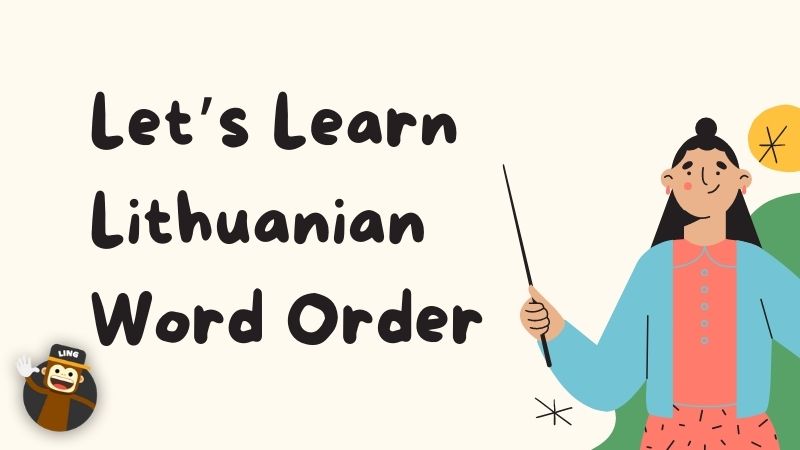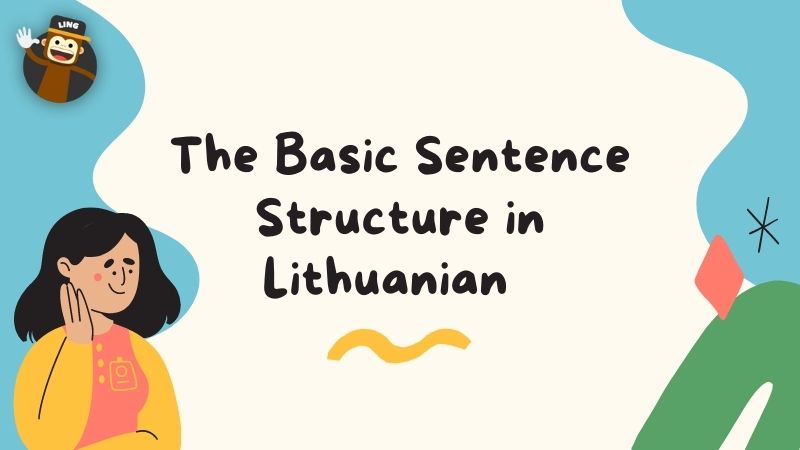You must wonder why we need to know basic sentence structure in Lithuanian to grasp the minimal idea of learning the new language. The answer is that grammatical structures will always be the primary path to learning an entirely new language. While the Lithuanian language can be attainable with essential words and phrases, knowing the Lithuanian grammar, grammatical numbers, sentence structure, and other elements will help you improve more precisely.
Thus, this blog has prepared a concise guide on Lithuanian sentences and word order to save you time from endless textbook notes. Learning the Lithuanian language with precision will help you speak Lithuanian words more fluently and correctly. So, let’s start learning Lithuanian right away!

Basic Sentence Structure In Lithuanian Language
When it comes to the sentence structure or word formation and word order of Lithuanian, it is quite neutral to other languages and does not seem too vague. The Lithuanian grammar retains the normal sentence structure of the Subject Verb Object. However, the fun thing about the word order in Lithuanian grammar is that it is flexible to more possibilities. While English may stick to one order that is Subject-Verb-Object in almost all cases, it may change and take other word orders as a shift in the order expresses changing emphasis in modern Lithuanian grammar.
Before we get more into the order of words, let us get a clear picture of what we are referring to as Subject, Verb, and Object.
Lithuanian Sentence Structure: Subject
The Subject is the main part of the Lithuanian sentence structure, which is the acting noun. The Subject or the noun (belonging to common nouns or proper nouns), which can be of masculine or feminine usage, always marks the grammatical center. For instance, “She is eating.” (ji valgo) Here, “she” or ji is the Subject. In Lithuanian grammar, the Subject is usually written at the beginning, so the order where the subject comes at the beginning and the Verb later is quite common.
The Subject or the noun can be one of the two genders, masculine nouns or masculine gender and feminine nouns or feminine gender. Sometimes it can also be of neutral gender or neuter gender as there are no strict rules governing the gender in Lithuanian. Subjects also have grammatical numbers. It can be singular nouns, plural words, and dual. However, only a few words in Lithuanian demonstrate an indefinite number. Fun fact, Lithuanians do not use any articles.
Lithuanian Sentence Structure: Object
The Object is the part of the sentence that also consists of a noun, but here the noun is rather being acted upon. It is not similar to a subject noun, as an object word or noun is the word that the subject is acting upon. It is not the center of the sentence. In Lithuanian sentence structure, the Object usually comes at the end after introducing the Subject and the Verb. However, it can appear in the beginning or even in the middle without hesitation, depending on the person’s willingness to convey it.
For instance, “He is baking a cake” (Jis kepa pyragą). Here, “He” (Jis) is the Subject, and “cake” (pyragą) is the denoted Object. Objects are mostly common nouns with or without masculine inflections or feminine genders.
Lithuanian Sentence Structure: Verb
Coming to another important part of the Lithuanian structure, the Verb. The Verb is the doing part of the sentence. It is the action or activity that someone or something is performing. In Lithuanian verbs, there exists stem plus suffixes. It belongs to a pro-drop family where Lithuanian pronouns are mostly dropped as the verbs already provide factual information about the person.
For instance, “She is sleeping” (Ji miega) here, “Sleeping,” or Miega is the Verb performed by the Subject.

Basic Word Order In Lithuanian
Coming back to the main element, the word order of the sentence structure of the Lithuanian grammar. While Subject+Verb+object is the common one we have seen in every example, Lithuanian being a declined language, considers free word order. It can be Subject+Object+Verb, Verb+Subejct+Object, and all the possible interrelations. However, as mentioned earlier, different order indicates different meanings, and there are strict rules that one has to follow. That is to say that Lithuanian words that have rheme or comment (new information) are usually set behind other words.
Again, with Lithuanian adjectives (describe material modifying nouns), the order of the adjective group is different in Lithuanian than in English. When the normal word order is followed, a casual, local, or temporal adjunct is set right at the beginning of the sentence. But in the case of other types of adjuncts, they are placed in front of the Verb and Object.
When describing structure with theme and rheme, the structure can be seen as complementary words followed by theme, middle words, rheme, and then final clauses. The central terms, theme, and rhyme are the most important in such a case. So, the Subject and the Verb often serve as the theme and rheme, and without them, a sentence is incomplete.
Examples Of Basic SVO Sentences
| Sentence | Subject | Verb | Object |
|---|---|---|---|
| Ji valgo makaronus (She is eating pasta) | Ji (She) | valgo (eating) | makaronus (pasta) |
| Sia mėgsta šokoladą (Sia loves chocolate) | Sia | mėgsta (like) | šokoladą (chocolate) |
| Jis verda ryžius (He is cooking rice) | Jis (She) | verda (cooking) | ryžius (rice) |
| aš geriu pieną (I am drinking milk) | aš (I) | geriu (drinking) | pieną (milk) |
| Jie skaito laikraštį (They are reading the newspaper) | Jie (They) | skaito (reading) | laikraštį (newspaper) |
| Jis važinėja dviračiu (He is riding a bike) | Jis (He) | važinėja (riding) | dviračiu (bike) |
Want to use these words in sentences? Practice with the Ling app on the Play Store or App Store. You can use this app anywhere, anytime!
Is Lithuanian Grammar Hard?
Lithuanian language belongs to the language family of the Baltic languages. It is one of the only two alive Baltic languages in the world. Lithuanian stands as the official language of Lithuania and is an ancient language. That precisely states that the Sankrit and proto Indo-European languages heavily influence the Lithuanian language and its grammatical structure. However, that does not make Lithuanian impossible to learn. Especially if you know the Latvian alphabet, it may be easier as they use the same Latin alphabet.
The basic sentence structure of the Lithuanian language, as we will learn in detail in the next section, is quite similar to that of English. However, they have one uniqueness that we need to pay strict attention to. If you keep reading below, you will get to know the flexibility and intensity of Lithuanian writing, grammar, and structures. So, don’t hesitate and explore the beauty of the Lithuanian language.
Learning The Lithuanian Language With Ling
That’s it for learning the sentence structure in Lithuanian. Now that you are on your way to acquiring the Lithuanian language in a very detailed manner, reach out to Ling to find out more interesting facts and rules. The Ling app has numerous content on vocabulary and grammar that will help you get a clear idea about a foreign language without even trying out new courses or textbooks. Just click and get to read amazing blogs on topics such as Funny Phrases In Lithuanian and Lithuanian Culture.
Ling has language experts from all over the world and has expertise in more than 60 languages. Even if you are interested in other Indo-European languages, you can go for it. Access the app and start learning today!



















